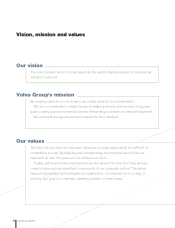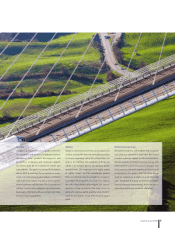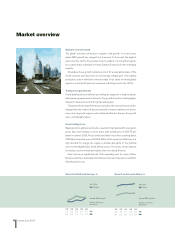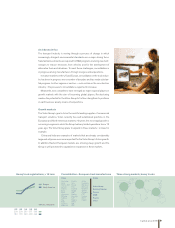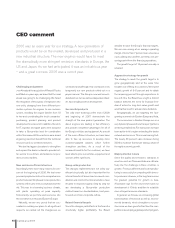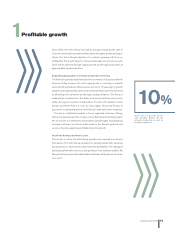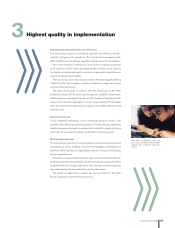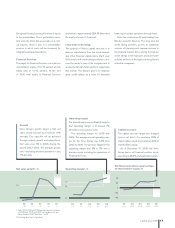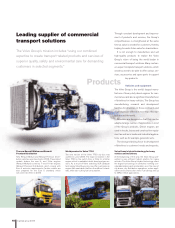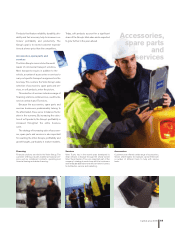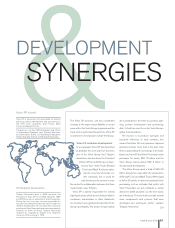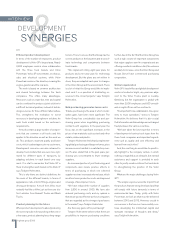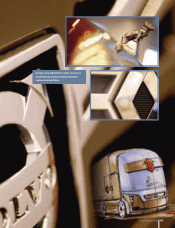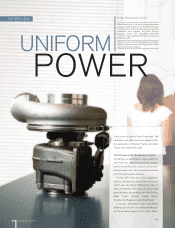Volvo 2006 Annual Report Download - page 20
Download and view the complete annual report
Please find page 20 of the 2006 Volvo annual report below. You can navigate through the pages in the report by either clicking on the pages listed below, or by using the keyword search tool below to find specific information within the annual report.
Financial strategy
New financial targets – Structurally higher
profitability, stronger cash flow and lower risk
Volvo’s Board of Directors believes that the Volvo Group currently has structurally
higher profitability, stronger cash flow and lower risk. Consequently, in September
2006 the Board decided to revise the company’s financial targets. The three
financial targets cover growth, profitability and capital structure.
Focus on commercial transport
solutions
The streamlining of the Volvo Group, which
commenced with the sale of passenger car
operations in 1999 and continued in the form
of a number of successful acquisitions, has
created a strong group with a renewed focus on
commercial vehicles and equipment. A new
organization featuring business units with
Group-wide responsibility for engines and
product development, purchasing and product
planning has fuelled in-house efficiency pro-
grams and ensured the realization of the con-
siderable potential synergies. These targeted
efforts have created business areas that indi-
vidually have strong positions in their particular
markets, while simultaneously capitalizing fully
on the potential offered for coordination and
cooperation deriving from the dramatically
higher volumes of engines and other products.
Overall, the Volvo Group’s new composition
has led to structurally higher margins and
stronger cash-flow. Higher earnings have led
to a sharp increase in dividends in recent years,
while also creating resources that have been
used for product development, geographic
expansion and other developments. In turn,
this has resulted in geographic and product
diversification that has also reduced risk in the
company. Moreover, the Volvo Group’s strong -
er focus on aftermarket operations, which are
less sensitive to economic trends has contrib-
uted to reducing risk.
Financial strategy
The purpose of Volvo’s long-term financial
strategy is to ensure the best use of Group
funds in providing shareholders with a favor-
able return and offering creditors reliable
security.
However, a prerequisite for the long-term
competitive development of the company is
the availability of sufficient financial resources
to secure investments and active participation
in industry consolidation worldwide, thereby
maintaining a strategically competitive pos-
ition in all business areas.
The Volvo Group’s financial resources will
be used for investments, acquisitions and a
competitive dividend with a stable and long-
term development. Any surplus capital will be
transferred to the shareholders.
New financial targets
• Growth in net sales should increase by at
least 10 percent annually.
• Operating margin should exceed 7 percent
for for the Group’s industrial operations over
the business cycle.
• Net debt should be a maximum of 40 percent
of shareholders’ equity.
The growth target of 10 percent annually will be
achieved through organic growth and through
acquisitions at approximately equal propor-
tions.
The Volvo Group’s new profitability target is
that operating margin is to exceed 7 percent
annually over a business cycle. The target cov-
ers all Group operations, except Financial
Services, which currently contributes approxi-
mately one additional percentage point.
The Volvo Group’s capital is intended primar-
ily for the financing of acquisitions, and for
maintaining a high level of financial flexibility,
any surplus capital will then be transferred to
Volvo’s shareholders. The limiting level of net
debt to a maximum of 40 percent should mainly
be regarded as a reserve that can be used in
the event of a major acquisition.
The financial resources of the Group must
be used as efficiently as possible to ensure and
further strengthen the profitability within the
16 A global group 2006


